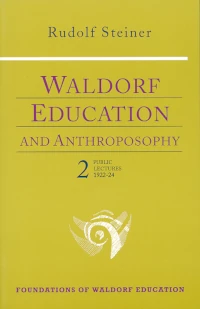Waldorf Education and Anthroposophy II
GA 304a

The present collection of public lectures given by Rudolf Steiner between 1922–1924 has not previously appeared in English. It may be regarded as a continuation of the collection of public lectures printed under the title Waldorf Education and Anthroposophy 1.
By this time Rudolf Steiner had achieved considerable public prominence. His lectures and travels were regularly reported in the press, and the Waldorf school movement was gaining increasing recognition. Emil Molt, the owner and managing director of the Waldorf Astoria Cigarette Factory and a long-time anthroposophist, had made this educational movement possible by asking Steiner to found a school at his factory. At its inception, the school provided a broad education for the children of the workers. Emil Molt was conscious of the needs of the working people; his social commitment was generous and profound.
From that endeavor arose the first Waldorf school, which opened its doors in Stuttgart in September 1919 with one hundred and thirty children in eight grades. After four years, it had grown to accommodate eight hundred students in twelve grades. By then, many families outside the Waldorf Astoria factory had enrolled their children in
| I. | Education and Teaching (GA 218) | November 19, 1922 |
| II. | The Art of Teaching from an Understanding of the Human Being (GA 218) | November 20, 1922 |
| III. | Education and Art | March 25, 1923 |
| IV. | Education and the Moral Life | March 26, 1923 |
| V. | Introduction to a Eurythmy Performance of the Waldorf School Pupils (GA 277d) | March 28, 1923 |
| VI. | Why Base Education on Anthroposophy I | June 30, 1923 |
| VII. | Why Base Education on Anthroposophy II | July 1, 1923 |
| VIII. | Waldorf Pedagogy | August 10, 1923 |
| IX. | Anthroposophy and Education | November 14, 1923 |
| X. | Moral and Physical Education | November 19, 1923 |
| XI. | Educational Issues I | August 29, 1924 |
| XII. | Educational Issues II | August 30, 1924 |

